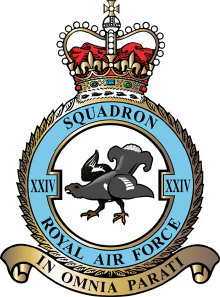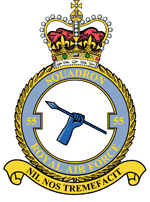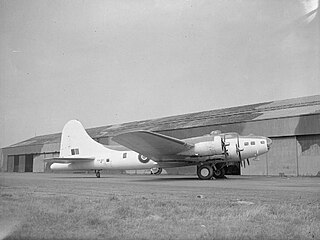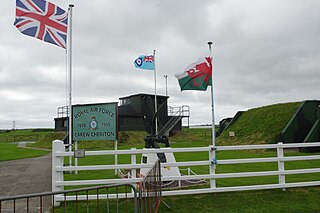
No. 206 Squadron is a Test and Evaluation Squadron of the Royal Air Force. Until 2005 it was employed in the maritime patrol role with the Nimrod MR.2 at RAF Kinloss, Moray. It was announced in December 2004 that 206 Squadron would disband on 1 April 2005, with half of its crews being redistributed to Nos. 120 and 201 Squadrons, also stationed at Kinloss. This was a part of the UK Defence Review called Delivering Security in a Changing World; the Nimrod MR.2 fleet was reduced in number from 21 to 16 as a consequence.

Number 8 Squadron of the Royal Air Force last operated the Boeing E-3D Sentry AEW1 (AWACS) from RAF Waddington, Lincolnshire. As of 2020, the RAF AWACS fleet was made up of three Sentry AEW1s, down from seven originally ordered in the late 1980s. Pursuant to the 2021 defence review, the E-3D Sentry aircraft made its final flight in U.K. service in August 2021.

Number 120 Squadron or No. CXX Squadron is a squadron of the Royal Air Force which was established as a Royal Flying Corps unit late in World War I, disbanded a year after the end of the war, then re-established as a RAF Coastal Command squadron during World War II. Although disbanded again a month after Victory in Europe Day, during and after World War II it operated almost continuously, with maritime patrol aircraft; most recently with the Hawker Siddeley Nimrod, based at RAF Kinloss in Scotland until the type's withdrawal in March 2010. The squadron was disbanded again the following year. No. 120 Squadron stood up again in April 2018 at RAF Lossiemouth and became the first squadron to be equipped with the Boeing Poseidon MRA1 anti-submarine warfare (ASW) aircraft on 31 October 2019.

No. 24 Squadron (also known as No. XXIV Squadron) of the Royal Air Force is the Air Mobility Operational Conversion Unit (AM OCU). Based at RAF Brize Norton in Oxfordshire, 24 Squadron is responsible for aircrew training on A400M Atlas and C17 Globemaster. The squadron also delivers or oversees engineer training for these aircraft.

No. 220 Squadron of the Royal Air Force (RAF) was founded in 1918 and disbanded in 1963 after four separate periods of service. The squadron saw service in both the First and Second World Wars, as a maritime patrol unit, and finally as part of Britain's strategic nuclear deterrent.
Royal Air Force Bircham Newton or more simply RAF Bircham Newton is a former Royal Air Force station located 2.1 miles (3.4 km) south east of Docking, Norfolk and 13.4 miles (21.6 km) north east of King's Lynn, Norfolk, England.

Number 55 Squadron was a flying squadron of the Royal Air Force (RAF). First formed in April 1917, the squadron saw action on the Western Front during the First World War. Based in the Middle East during the interwar period and the Second World War, No. 55 Squadron saw action over Iraq, Egypt, Libya and Italy. Between 1960 and 1993, the unit flew the Handley Page Victor. Initially on the Victor B.1A before becoming a tanker squadron in 1965 with the Victor B(K).1A/K.1/K.1A before converting to the Victor K.2 in 1975. Disbanding in October 1993, No. 55 Squadron were the last RAF unit to operate the Victor. Between 1996 and 2011, No. 55(Reserve) Squadron operated the Hawker Siddeley Dominie T.1 from RAF Cranwell, Lincolnshire, helping to train navigators for the RAF.

Number 207 Squadron is a historic bomber squadron and, latterly, a communications and flying training squadron of the Royal Air Force. It was announced on 5 July 2017 that No. 207 Squadron will again reform to become the Operational Conversion Unit for the UK F-35B Lightning Force and will return to RAF Marham in Norfolk where it was last based in 1965. No. 207 Squadron arrived at RAF Marham with six F-35Bs on 16 July 2019 before officially standing up on 1 August.

No. 251 Squadron was a Royal Air Force Squadron which operated during the First World War and the Second World War. The Squadron was disbanded in 1945 and remains inactive.

No. 104 Squadron RAF is a former squadron of the British Royal Air Force.
No. 228 Squadron RAF was a squadron of the Royal Air Force active at various times between 1918 and 1964. It spent the greatest part of its existence flying over water, doing so in the First, and Second World Wars and beyond, performing anti-submarine, reconnaissance and air-sea rescue tasks.

No. 269 Squadron RAF was a maritime patrol unit of the Royal Air Force that saw service in World War I, World War II, and the Cold War.

Royal Air Force Haverfordwest or more commonly RAF Haverfordwest, is a former Royal Air Force station located 2.1 miles (3.4 km) north of Haverfordwest, Pembrokeshire and 11 miles (18 km) south of Fishguard, Pembrokeshire, Wales.

Royal Air Force Carew Cheriton, or more simply RAF Carew Cheriton, is a former Royal Air Force station located near Carew, Pembrokeshire. It was situated 4.7 miles (7.6 km) north west of Tenby.
No. 108 Squadron RAF was originally a squadron of the Royal Flying Corps during the First World War which continued to serve with the Royal Air Force in the Second World War.

No. 217 Squadron RAF was a squadron of the RAF. It was formed and disbanded four times between 1 April 1918 and 13 November 1959. In World War I it served in a strike role against enemy bases and airfields in Belgium. In World War II as part of RAF Coastal Command it served first in a maritime patrol role along the Western Approaches and later in an anti-shipping role in the English Channel. Ordered to the Far East in 1942, the squadron was retained for two months in Malta in an anti-shipping role, protecting Allied convoys, before moving to Ceylon to defend the approaches to India, serving in an anti-submarine and anti-shipping role. It was equipped and training for a strike role, when the war ended. In the postwar period, it served for five years in a maritime reconnaissance role, and then briefly in a support role for Operation Grapple, the British hydrogen bomb tests on Christmas Island.

No. 1 (Coastal) Operational Training Unit RAF, was a training unit of the Royal Air Force, within No. 17 Group RAF, which was part of RAF Coastal Command. The unit was established during April 1940 by the redesignating of an existing RAF Coastal Command unit, and disbanded during October 1943.

No. 15 Group was a group of the Royal Air Force, which disbanded in 1945. It was operational in the last year of, and just after, the First World War, a reformation saw it active throughout the Second World War.

No. 16 Group RAF was a group of the Royal Air Force. It existed over two periods in two different roles. No. 16 Group was initially a training group, from 1918 to 1920, that had been transferred from the Royal Flying Corps. It reformed as a reconnaissance group under RAF Coastal Command, in 1936.

No. 17 Group RAF was a group of the Royal Air Force which was operational in the last year of the First World War, and throughout the Second World War.















